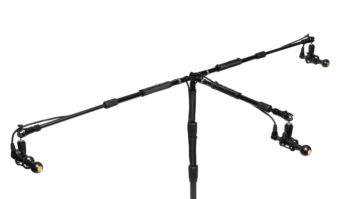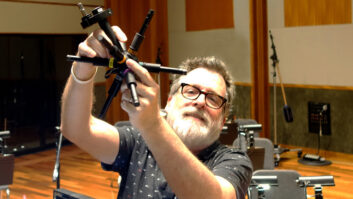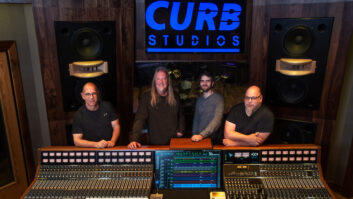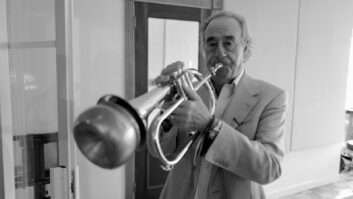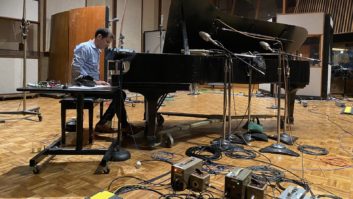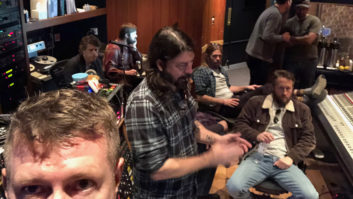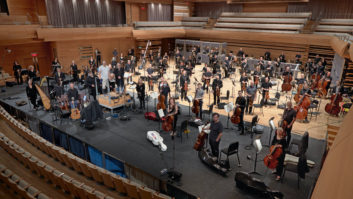
Ever since the 1930s, when early experiments in stereo transmissiontechniques were conducted on both sides of the Atlantic, two basic butradically different approaches to stereophonic recording —coincident microphones vs. spaced microphones — have coexisted.Each has its own camp of followers who champion its particularattributes and often denigrate those of the other.
One of these techniques employscoincident microphones to create a stereophonic pickup basedentirely on the intensity differences generated between a pairof microphones as the soundwave passes by. Its claim to fame relies onthe strong stability and clear articulation of the stereophonic imagethat it creates. Its primary drawback, however, is a somewhatconstricted image width and what some people consider to be a tendencyto sound “dry” or “sterile.” The other approachuses two (or sometimes three) spaced microphones to capture andreproduce both the soundwave’s intensity andtime-of-arrival cues as it passes by the microphone array. Anatural result of these time-of-arrival cues is a greater sense of“spaciousness” than can be achieved with solelyintensity-derived techniques. The drawback, however, is a lack ofarticulation across the stereophonic image and what many listenersconsider ambiguity in the center imaging.

Thus, these two camps have staunchly opposed one another: coincidentmicrophones vs. spaced microphones and articulation vs. spaciousness.And in the age of multichannel, surround sound production, listenersdemand both an articulate image and spatial envelopment from thesoundtrack. The logical solution, therefore, is to employ techniquesthat combine the best attributes of both coincident and spacedmicrophones. Choose your compromises wisely.
STARTING WITH THE BASICS: BLUMLEIN AND STEREO
In the early 1930s — when early experiments inspaced-microphone (left-center-right) stereo were being conducted inthe U.S. by the engineers at Bell Laboratories — Britishscientist Alan Blumlein, working for EMI on the other side of theAtlantic, was developing the concepts of coincident microphonetechniques. His pioneering work was codified in a patent that wasissued in 1933, in which he defined and described a technique to createa stable and articulate stereophonic image by using just two crossedbidirectional microphones, a configuration that has come to bear hisname: the Blumlein technique.
Blumlein realized that by using the unique cosine pattern ofbidirectional (figure-8) microphones, the principal pickup axis of onecould be precisely co-aligned with the axis of minimal pickup (thenull-plane) of another, resulting in a very stable, extremely accurateand well-articulated stereophonic image, one that relies entirely onthe differences in the intensity cues as the sound reaches each of thetwo microphones. (See Fig. 1.)
In the same patent, Blumlein also described a mathematicaltransformation of these crossed bidirectionals, which he termed theMid/Side Technique. This also employs a bidirectional microphone— the Side microphone, which is oriented laterally with thenull-axis aimed directly at the sound source — to provide theessential directional contribution to the stereophonic imaging. The Midmicrophone provides the overall pickup. Its principal pickup axis isaimed directly at the sound source; again, co-aligned with the nullaxis of the bidirectional microphone. Although not yet a conventionalstereophonic pickup, when the signals of these two microphones arecombined via a sum-and-difference matrix system, left and rightstereophonic signals result: Mid + Side = Left; Mid – Side = Right.(See Fig. 2.)
It is important to note that although convention depicts the Midmicrophone as cardioid, it may be any polar pattern, fromomnidirectional to bidirectional. At the same time, the ratio ofMid-to-Side signals introduced into the matrix can vary. By virtue ofthese two variables (Mid-mic polar pattern and Mid-to-Side ratio), aninfinite variety of “virtual stereo pairs” can be createdusing this technique.
THE DECCA TREE: A HISTORICAL PERSPECTIVE
Since its inception, the Decca Tree has been widely used forlarge-scale recordings and is a favorite among film scoring mixersbecause of its ability to maintain excellent imaging and separationeven through the various matrix-encoding systems used to distributefilm soundtracks.
We can trace its origins to March of 1954, when engineers RoyWallace and Arthur Haddy at the Decca Studios in London prepared for arecording session with the Mantovani Orchestra. Always experimenting inthe then-new medium of stereo, Wallace assembled a T-shape steel array(shown in Fig. 3) and attached Neumann M49 microphones to each of thethree ends. (The left and right microphones were“hard-assigned” to their respective channels, and thecenter mic was assigned equally to the two channels but at a somewhatlower level to avoid “center buildup.”) He then suspendedthe entire array from a large studio boom, above and slightly behindthe conductor’s podium. Wallace recalls: “It was a crude attemptto re-create the artificial head that I spent about a yearmaking.” When Haddy first saw the array, he remarked: “Itlooks like a bloody Christmas Tree!” The name stuck.
In later revisions, Wallace and Haddy used Neumann KM56 microphones,sometimes experimenting with a “Blumlein shuffler” (customEQ employed to augment the low-frequency content of the differenceinformation in a stereo signal). Further refinements by Decca engineersKen Wilkinson and Stan Goodall evolved the classic “DeccaTree” as we know it today: three Neumann M50 omnidirectionalmicrophones arrayed as shown in Fig. 1.
Because the sound arrives at the center of the tree — forwardmicrophone slightly earlier than the left/right pair — the Law ofthe First Wavefront guarantees that this central image will be stronglyfocused and clear. This results in a significant improvement overprevious spaced-microphone configurations, which were criticized forpresenting poor or diffused central imaging.
THE BEST OF BOTH WORLDS
A frequent criticism of the coincident Blumlein and Mid/Side pickupsis that their stereo imaging tends to be constricted and lacks thespaciousness provided by near-coincident or spaced arrays. Conversely,spaced-microphone techniques are criticized for not providing the sameclear, articulate image that can be obtained with coincidentconfigurations. An easy and obvious solution to this controversy is tocombine the desirable attributes of both techniques.
Long an advocate of Mid/Side recording, I began experimenting in thelate 1980s with a variation of the Decca Tree that used a M/Smicrophone pair — rather than a single omni — as thefront-center pickup. (See Fig. 4.) My goal was to maintain the vitalityand articulation from the M/S pickup, while “broadening” itslightly and providing the spaciousness that could be had only from theseparated, flanking microphones. To preserve the sonic integrity of theentire array, in my initial experiments, the center-stereo microphonewas an AKG C426 and the flanks were AKG C414s: all large-diaphragmcondensers using the same capsule design. Various spacings were tried,both front-to-back and side-to-side, which were determined by the sizeof the performing ensemble and of the performance space. I createdconfigurations that ranged in size: from a “mini tree” thatwas one meter wide and a half-meter deep, to the“full-size” tree with the standard spacing of two meters byone meter.
THE EVOLUTION OF THE “SURROUND SOUND” DECCA TREE
Building on my experiments with the Decca Tree, I have developed anexpanded surround sound configuration: a Mid/Side microphone —or, for a more complete surround experience, the SoundField Mk-Vmicrophone — as the front/center pickup and two pairs of flankingmicrophones on the rear bar. One of these pairs is aimed forward(toward the sound source) and serves to “flank” thecenter-stereo pickup in the front left and right channels, as describedabove. The second pair is aimed at the rear and provides the essentialsignals for the surround channels. This microphone configuration cancombine several discrete stereophonic pairs into a complex and widelyvariable complement of conventional frontal stereo and/or surroundpickups. (See Fig. 5.)
An important attribute of this array is that all of the microphonesare relatively closely spaced so that minimal phasing anomalies orcancellations result if/when these signals are mixed down to“smaller” formats, such as conventional stereo or evenmono. Remember, with all spaced-microphone techniques, phasecancellations are unavoidable and some comb filtering will inevitablyresult. However, due to the relatively close proximity among themicrophones on the Decca Tree, these effects will be less obvious thanwith more widely spaced arrays.
For a conventional stereophonic (2-channel) recording, the surroundmicrophones in Fig. 5 can be mixed with the other mics’ signals to addambience and/or natural reverberation. This will also be reasonablycoherent because it is well within the “fusion zone” of theprimary stereo signals. An ideal choice for these surround microphonesis a pair of hypercardioids with a good off-axis response (such as theSchoeps MK41 or Neumann AK50 capsules). Because the rear lobes of thesehypercardioids tend to “cross” the channels of the frontstereophonic image (i.e., the left microphone picks up the right sideand vice versa), a “purist” might prefer to use cardioids.To me, this cross-channel effect actually increases the sense ofenvelopment in the total sonic perspective, particularly if the nullangle of each of these surround mics is aimed directly at its opposite;very much akin to the crossing of the nulls in a conventional Blumleinpair.
When a SoundField Mk-V microphone system is employed as thefront/center pickup, additional options for surround sound recordingare available, because this unique microphone inherently provides asurround sound pickup in its own right. With the SoundField SP451Surround Sound Processor, the system produces a full 5.1 surround arraywith complete variability of the balance and sonic perspective. Bycombining the SoundField’s coherent surround signals with the 2&3and 4&5 spaced-microphone pairs in Fig. 5, it is possible to createan even broader spectrum of stereophonic and/or surround sound images,while at the same time, satisfying the desire for both articulation andaccuracy of the sonic image, as well as breadth and spaciousenvelopment of the listener: the best of both worlds.
ASSEMBLING AND USING THE SURROUND TREE ARRAY
It is possible, of course, to configure a surround sound Decca Treearray by placing (or suspending) each of the microphones individuallyin the appropriate relationships to each other. This can, however, becumbersome and time-consuming, because it requires five stands orhanging rigs. A more convenient method is to mount all of themicrophones onto a common Decca Tree fixture and then support theentire array from above or below as appropriate. Stand-mountingprovides the most ease and flexibility of placement, but the array canbe “flown,” as well.
As shown in Fig. 5, a SoundField Mk-V serves as the front/centermicrophone pickup; two subcardioid microphones are the 2&3 pair;and a pair of hypercardioid microphones is the 4&5. Of course, anymicrophones can be used. Experiment for yourself and have fun. Afterall, creativity is the essence of the recording experience.
5.1 AND BEYOND
The basic loudspeaker arrangement for 5.1 surround systems has beendefined as a front pair, a center and a surround pair, plus subwoofer.Many advocates of surround sound systems, however, urge even morechannels and loudspeakers. Many home-theater systems now offer a 7.1configuration, adding two loudspeakers directly to the side of thelistener. These additions enhance the sense of envelopment by providingincreased early-lateral (reflection) signals. When the surround soundDecca Tree employs the SoundField Mk-V microphone as its front/centerpickup, the array can provide sufficient discrete directionalinformation to generate a 7.1 surround system, because either theSoundField or the rear-facing microphones (or a combination of both)can be used to derive the side or surround signals, or vice versa. Ifthe surround sound Decca Tree is combined with a second pair ofambience (or additional surround) mics, then the surround depth and/orthe number of channels can be expanded geometrically.
CONCLUSION
Combining the various elements of the surround sound Decca Tree is amatter of personal and/or professional taste. If a more articulatedimage is desired, then the coherent or coincident components shoulddominate the mix. To achieve a more “spacious” sound, theL/R2 and L/R3 pairs may be increased. Additional microphones can alsobe added to the mix to highlight individual sections or soloists and/orto augment the surround experience. Technology, like creativity, knowsno bounds.
The author wishes to thank Roy Wallace, Michael Gray and TonyFaulkner for their kind correspondences that provided unique personalinsights into the historical background of the Decca Treedevelopment.
President-elect of the AES, Ron Streicher wears many hats: anoted classical engineer/producer, educator, lecturer and author of thelandmark text The New Stereo Soundbook.

Flying a microphone array can be tricky business, takinginto many acoustic- as well as safety-considerations. Learn more aboutrigging and configuration with this guide by Ron Streicher.
